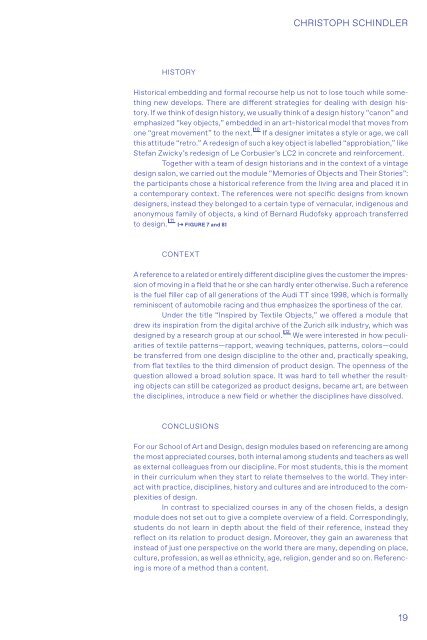Formful Wood. Explorative Furniture
ISBN 978-3-86859-588–8 https://www.jovis.de/de/buecher/product/formful-wood-explorative-furniture.html
ISBN 978-3-86859-588–8
https://www.jovis.de/de/buecher/product/formful-wood-explorative-furniture.html
Create successful ePaper yourself
Turn your PDF publications into a flip-book with our unique Google optimized e-Paper software.
CHRISTOPH SCHINDLER<br />
HISTORY<br />
Historical embedding and formal recourse help us not to lose touch while something<br />
new develops. There are different strategies for dealing with design history.<br />
If we think of design history, we usually think of a design history “canon” and<br />
emphasized “key objects,” embedded in an art–historical model that moves from<br />
one “great movement” to the next. 10 If a designer imitates a style or age, we call<br />
this attitude “retro.” A redesign of such a key object is labelled “approbiation,” like<br />
Stefan Zwicky’s redesign of Le Corbusier’s LC2 in concrete and reinforcement.<br />
Together with a team of design historians and in the context of a vintage<br />
design salon, we carried out the module “Memories of Objects and Their Stories”:<br />
the participants chose a historical reference from the living area and placed it in<br />
a contemporary context. The references were not specific designs from known<br />
designers, instead they belonged to a certain type of vernacular, indigenous and<br />
anonymous family of objects, a kind of Bernard Rudofsky approach transferred<br />
11<br />
to design. [→ FIGURE 7 and 8]<br />
CONTEXT<br />
A reference to a related or entirely different discipline gives the customer the impression<br />
of moving in a field that he or she can hardly enter otherwise. Such a reference<br />
is the fuel filler cap of all generations of the Audi TT since 1998, which is formally<br />
reminiscent of automobile racing and thus emphasizes the sportiness of the car.<br />
Under the title “Inspired by Textile Objects,” we offered a module that<br />
drew its inspiration from the digital archive of the Zurich silk industry, which was<br />
designed by a research group at our school. 12 We were interested in how peculiarities<br />
of textile patterns—rapport, weaving techniques, patterns, colors—could<br />
be transferred from one design discipline to the other and, practically speaking,<br />
from flat textiles to the third dimension of product design. The openness of the<br />
question allowed a broad solution space. It was hard to tell whether the resulting<br />
objects can still be categorized as product designs, became art, are between<br />
the disciplines, introduce a new field or whether the disciplines have dissolved.<br />
CONCLUSIONS<br />
For our School of Art and Design, design modules based on referencing are among<br />
the most appreciated courses, both internal among students and teachers as well<br />
as external colleagues from our discipline. For most students, this is the moment<br />
in their curriculum when they start to relate themselves to the world. They interact<br />
with practice, disciplines, history and cultures and are introduced to the complexities<br />
of design.<br />
In contrast to specialized courses in any of the chosen fields, a design<br />
module does not set out to give a complete overview of a field. Correspondingly,<br />
students do not learn in depth about the field of their reference, instead they<br />
reflect on its relation to product design. Moreover, they gain an awareness that<br />
instead of just one perspective on the world there are many, depending on place,<br />
culture, profession, as well as ethnicity, age, religion, gender and so on. Referencing<br />
is more of a method than a content.<br />
19


















